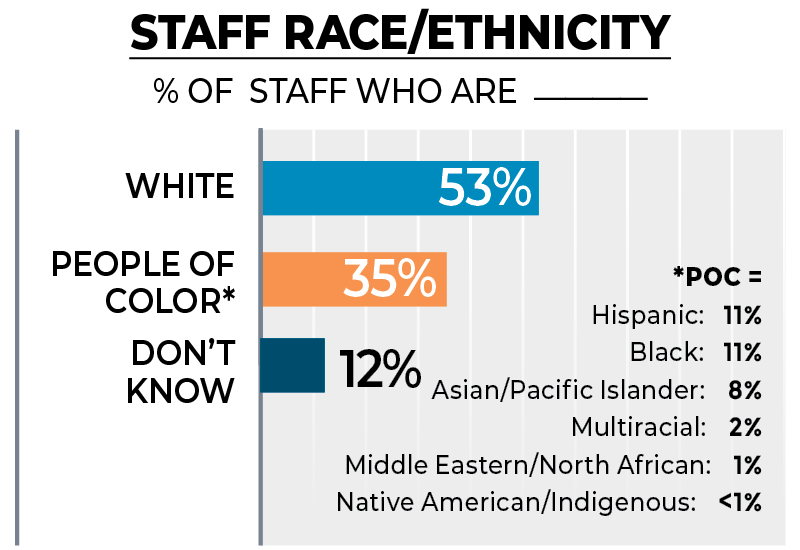Key Challenges & Opportunities
While the Index findings show a sustained pattern of growth and stabilization, they also illuminate challenges that could slow or limit the field’s growth, or accelerate it if the challenges are met. They include broadening gains in staff diversity, addressing the uneven distribution of major philanthropy, and the need and opportunity to develop more market-based revenue that aligns with the public service mission of nonprofit news.
Staff diversity gains are driven by startups
As staff counts across the nonprofit news field grow, racial and ethnic diversity levels have kept pace. Across the nonprofit news sector, about half (53%) of nonprofit news staff are white and about a third (35%) are people of color. Leadership and board member breakdowns will next be available in INN’s 2023 Index Report.

Fieldwide race and ethnicity breakdowns more or less represent diversity levels from the prior year and, at the most basic level, are roughly representative of the U.S. labor force. The nonprofit news field also remains more racially and ethnically diverse than legacy media (the News Leaders Association’s 2019 ASNE Newsroom Diversity survey reported that people of color represent 22% of the salaried workforce and updated numbers are not available).
U.S. diversity on the rise. People of color make up 38% of the U.S. workforce and that share is projected to grow to 43% by 2028, according to the U.S. Bureau of Labor Statistics. People of Hispanic origin make up 18% of the total workforce. Black people account for 13%, Asian Americans for 6%, and “all other groups,” which includes multiracial, Native American/Alaska Native and Hawaiian/Pacific Islander, account for a small percentage.
Yet, the nonprofit news field has work to do and recognizes that diversity numbers from commercial media do not serve as impactful or equitable benchmarks. Racial and ethnic representation remains highly variable across the nonprofit news field. Startups serving communities of color are driving much of the field’s diversity gains, whereas long-established nonprofit organizations serving more general audiences tend to lag behind. About a third of all outlets – 35% – account for 83% of all staff of color fieldwide. A large portion of that third of the field is startups and outlets with a primary mission to serve communities of color.
Among the outlets not primarily serving communities of color, 58% of staff are white and 28% are people of color. Some outlets did not provide diversity figures for their staff, accounting for the remaining 14%.
INN realizes these numbers require a broader look, especially since essential components of diverse, equitable and inclusive organizations cannot be measured by headcount, such as newsroom culture, support for staff and leadership of color, burnout and turnover. INN’s 2023 Index will focus on diversity, equity and inclusion.
Diversity numbers are not enough. Organizations must strive for equity and foster an inclusive environment and accurate coverage by ensuring all voices are heard, valued and reflected in news coverage. INN launched the Racial Equity and Inclusion in Nonprofit News program to help members advance racial diversity, equity and inclusion in their organizations and their journalism. INN is also working to become a more equitable and inclusive organization itself.
Concentration of foundation funding remains with national, global outlets
Foundation funding, a major fuel supplier for public service journalism, remains concentrated in the larger, national and global news outlets – and remains elusive for smaller, local organizations.
Comparing labor workforce sizes with total foundation funding shows this disparity. Local news outlets employ about a quarter of the nonprofit news sector, yet receive only about a tenth of the field’s foundation support. In contrast, national and global outlets employ a little over half of the field yet bring in close to 70% of the field’s foundation support.

The disparity is even more dramatic when comparing the number of outlets against total foundation dollars. National and global organizations make up roughly a quarter of all outlets surveyed, yet bring in over two-thirds of the field’s foundation funding. Compare that to local organizations, which comprise 42% of outlets across the field yet bring in only 11% of the field’s total foundation funding.
The direction of foundation funding affects total revenue breakdowns across different types of outlets. Global news organizations are primarily fueled by foundation funding: the typical global organization brings in 75% of total revenue from foundations. Local news organizations, on the other hand, typically derive 40% of their total funding from foundations. As a result of disproportionately low foundation funding, small local news organizations often have to invest more heavily in developing different revenue streams.
The discontinuity between foundation funding of large organizations and the growing needs of smaller, local outlets is dramatically raising a need gap in news philanthropy. Several funding programs, including NewsMatch, Rural News Network and other holistic collaborations that reinforce sustainability as well as expand editorial impact, and systemic funding initiatives such as Report for America, address this need by packaging and funneling donations to many smaller local and state news organizations, leveraging national funding as a catalyst for broader support. INN is looking at expanding those systemic solutions, and the issue merits more attention as local startups increasingly show success in preventing news deserts and addressing inequities in news access.
Foundation funding for organizations focused on serving communities of color equaled – at least in proportion – the amount of investment for the rest of the field. About one-fourth (28%) of the nonprofit journalism workforce operates at an organization whose primary mission is serving such communities. In 2021, 29% of foundation funding went to those organizations. Similarly, organizations that represent a higher degree of staff diversity (defined here as at least 40% journalists of color) were met with proportional philanthropic resources in 2021.
While encouraging, these numbers don’t address the extent to which BIPOC-led and focused organizations are playing catch-up. Nor do these numbers assume foundation funding will remain stable or grow for this cohort in the future. But the data at the very least suggest a sign of momentum that should encourage funders to double down.
Earned revenue remains an underdeveloped opportunity
Earned revenue (including sponsorship and advertising dollars from businesses and institutions) is inconsistent across the field, remaining a source of opportunity for most and yet underdeveloped for others. This is the revenue source that also appears to have been most affected by the pandemic, and it remains to be seen if those impacts will be temporary or slow the growth of earned revenue for an extended period. From 2018 through 2021, nearly half of outlets in our Index trend set reported gains in earned revenue. A third of outlets reported decreases over the four-year period.
Local outlets were hit hardest, largely due to the pandemic causing many local businesses to cut spending or close. The median earned revenue for local outlets dropped in 2020 and again in 2021 to just under $28,000 per outlet, lower by nearly a third than the pre-COVID level. Ten out of 22 local outlets in the Index trend set reported declines.
A handful of local news outlets were able to retain and even grow earned revenue throughout 2020 and 2021, including Madison 365, serving communities of color in Wisconsin and Patagonia Regional Times (PRT), serving communities in southeastern Arizona. The secret to these outlets’ success? Their leaders point to relationship-building between an outlet’s sales representative and businesses, and reframing advertising and sponsorship opportunities as a way to support high-quality information.
The PRT successfully retained its clients and revenue from earned sources from 2020 through 2021, largely by prioritizing its relationships with clients. PRT’s board president, Kathryn Schrag, said that in the summer of 2020 the staff and board of directors made the decision to offer all ads in the monthly print edition free of charge for one month, and at 50% reduction for two more months. Schrag points to this gesture as one successful strategy for maintaining relationships with clients over time – making the point that the exchange of dollars is more about uplifting a community rather than one organization profiting off another.
Madison365 grew its earned revenue from about $360,000 in 2020 to over $380,000 in 2021 and documented its revenue strategy in this INN case study. Since 2020, the team’s earned revenue tactics largely remained constant: leading with its mission in all business dealings, prioritizing creating custom “membership” packages with business clients, valuing relationships with clients, and committing to serve a specific audience.
How can nonprofit news build advertising, sponsored content and event sponsorship dollars into sustainable sources of revenue? INN documents earned revenue best practices for publishers in its Guide to Earned Revenue. One key finding: don’t sell widgets, sell solutions. In other words: Use a consultative selling approach that focuses on clients’ and prospects’ needs – and offer them solutions.
